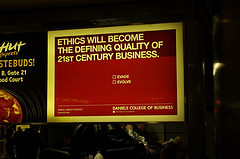|
|
|
March 22nd, 2009 by Miki Saxon
 Considering the business news for the last decade the title of this week’s quotes is more of an oxymoron. Considering the business news for the last decade the title of this week’s quotes is more of an oxymoron.
And, IMCO (in my cynical opinion), it’s not over yet. I think more schemes, more unethical if not downright illegal actions and a whole lot more stupidity are going to surface globally before we get out of this tunnel.
With that in mind I offer up these insights to the human psyche.
There are two levers to set a man in motion, fear and self-interest. –Napoleon Bonaparte (He should know.)
Capitalism is the astounding belief that the most wickedest of men will do the most wickedest of things for the greatest good of everyone. –John Maynard Keynes (That was then, now the wicked men do wicked things sans greatest good for anyone but them.)
Corporation, n., An ingenious device for obtaining profit without individual responsibility. –Ambrose Bierce (But it doesn’t have to be that way.)
Earnings can be pliable as putty when a charlatan heads the company reporting them.–Warren Buffett (Can you say derivatives, Madoff and hedge funds?)
If ethics are poor at the top, that behavior is copied down through the organization. –Robert Noyce (We really didn’t need anyone to prove Noyce’s wisdom.)
Your comments—priceless
Don’t miss a post, subscribe via RSS or EMAIL
Image credit: flickr
Tags: business, egos, ethical, unethical
Posted in About Leadership, Culture, Ethics, Group Dynamics, Leading Stupidities, management, Quotable Quotes, What Leaders DON'T |
No Comments »
Sphere: Related Content
*/?>
February 22nd, 2009 by Miki Saxon
Greed is certainly in the news these days, from stories about it to tirades against it, so it seemed like a good time to offer up a few you may not have seen recently.
“Greed is a bottomless pit which exhausts the person in an endless effort to satisfy the need without ever reaching satisfaction.” –Erich Fromm (Hello John Thain and friends, I think Erich is talking to you.)
“It always seemed strange to me that the things we admire in men, kindness and generosity, openness, honesty, understanding and feeling are the concomitants of failure in our system. And those traits we detest, sharpness, greed, aquisitiveness, meanness, egotism and self-interest are the traits of success. And while men admire the quality of the first, they love the produce of the second.” –John Steinbeck (This is so true it makes you want to weep.)
“To make a business decision, you don’t need much philosophy; all you need is greed, and maybe a little knowledge of how the game works.” –Bill Watterson (After listening to all the rationalizations and excuses for what’s happened this is the first thing that makes sense.
Finally, to round this out I’m adding something I said during a conversation. I can’t remember having read it, but I doubt it’s really original.
“Greed is the driving force in the pursuit of many things besides money.” Me
What about you? Any thoughts on greed—your own or someone else’s?
Your comments—priceless
Don’t miss a post, subscribe via RSS or EMAIL
Image credit: sxc.hu
Tags: Bill watterson, Erich Fromm, greed, John Steinbeck, John Thain
Posted in Ethics, Leadership Choice, Quotable Quotes, What Leaders DON'T |
8 Comments »
Sphere: Related Content
*/?>
January 4th, 2009 by Miki Saxon
 Greed, like water, just keeps flowing along, flooding the land and leaving destruction and misery in it’s wake. The current flood, which dwarfs Katrina, makes greed a timely subject for our quotes today. Greed, like water, just keeps flowing along, flooding the land and leaving destruction and misery in it’s wake. The current flood, which dwarfs Katrina, makes greed a timely subject for our quotes today.
“Laissez-faire, Supply-and-demand, – one begins to be weary of all that. Leave all to egoism, to ravenous greed of money, of pleasure, of applause: it is the Gospel of Despair!” –Thomas Carlyle (Said way back in the 1800s, seems nothing has changed—not encouraging.)
“It always seemed strange to me that the things we admire in men, kindness and generosity, openness, honesty, understanding and feeling are the concomitants of failure in our system. And those traits we detest, sharpness, greed, acquisitiveness, meanness, egotism and self-interest are the traits of success. And while men admire the quality of the first, they love the produce of the second.” –John Steinbeck (Good grief! You don’t confuse talk with actions, do you?)
“New York City is a great monument to the power of money and greed… a race for rent.” –Frank Lloyd Wright (Definitely living up to it’s reputation!)
“If we go on the way we have, the fault is our greed [and] if we are not willing [to change], we will disappear from the face of the globe, to be replaced by the insect.” –Jacques Cousteau (Long hail the mighty cockroach [see above].)
“No drug, not even alcohol, causes the fundamental ills of society. If we’re looking for the source of our troubles, we shouldn’t test people for drugs, we should test them for stupidity, ignorance, greed and love of power.” –P. J. O’Rourke (Whoever invents the test will wind up the richest person in the world without any need to be greedy!)
Your comments—priceless
Don’t miss a post, subscribe via RSS or EMAIL
Image credit: sxc.hu
Tags: Frank Lloyd Wright, greed, Jacques Cousteau, John Steinbeck, P J O'Rourke, Quotable Quotes, Thomas Carlyle
Posted in About Leadership, Ethics, Leadership Choice, Quotable Quotes, What Leaders DON'T |
5 Comments »
Sphere: Related Content
*/?>
August 11th, 2008 by Miki Saxon
 Awhile back I wrote several posts (rants?) on healthcare problems and some of the really terrible things that make my blood boil. Awhile back I wrote several posts (rants?) on healthcare problems and some of the really terrible things that make my blood boil.
Over the last couple of weeks several new article caught my eye and I wanted to bring them to your attention.
1. Following up a February post on doctors and medical researchers extensive conflicts of interest resulting from pharma industry funding and gifts.
Amazingly enough, two industry giants, Pfizer and Zimmer, which manufactures hip, knee, and elbow implants, are concerned about a potential conflict—although not about funding or gifts. This one is about ongoing physician education, often funded by industry players.
“At the center of this controversy are medical communications firms paid by pharmaceutical and device companies to produce physician-education courses. Critics say the manufacturers hire the marketing firms as intermediaries to help them influence doctors’ prescriptions and procedures.”
Gee maybe all the articles, investigations and general negative publicity coupled with a consumer revolt that might force action in Washington are having an effect.
2. It’s disgusting that financial institutions buy the debt of the un/under insured and then charge exorbitant interest rates on it.
Now the light is being shined on a practice that drives one more nail to the inability to buy insurance—assuming that you can even afford it.
“An untold number of people have been rejected for medical coverage for a reason they never could have guessed: Insurance companies are using huge, commercially available prescription databases to screen out applicants based on their drug purchases. … Most consumers and even many insurance agents are unaware that Humana, UnitedHealth Group, Aetna, Blue Cross plans, and other insurance giants have ready access to applicants’ prescription histories. These online reports, available in seconds from a pair of little-known intermediary companies at a cost of only about $15 per search, typically include voluminous information going back five years on dosage, refills, and possible medical conditions. The reports also provide a numerical score predicting what a person may cost an insurer in the future.”
3. We all know how important it is to wash our hands, but many of us are careless about doing it—including healthcare providers.
“Despite recommendations, nearly 60 percent of health-care workers do not wash hands while on duty. … Why? … For one thing, rigorous hand washing is time-consuming. Guidelines advise that we first rinse, then soap for 20 seconds, then rinse again for 30 seconds; after this, we paper-dry our hands and turn the faucet off using the paper towel. For health-care workers, the procedure is supposed to be followed before and after every patient encounter. That means two minutes per patient visit, which adds up to an hour for a doctor who sees an average 30 patients a day, and 2 1/2 hours per shift for an ICU nurse.”
Now, in an effort to force improvement, “Starting in October, hospitals will be penalized for the consequences of unwashed hands: Medicare will no longer pay for complications arising from certain hospital-acquired infections, which in many cases result from poor hand hygiene. This will be a powerful incentive for health executives to improve hand-washing compliance.”
Will it be an incentive? Or will the hospitals just bill the patient for what Medicare doesn’t cover and then sell the receivables to the highest bidder?
4. A possible bright spot—at least for those who work in large companies. It’s on-site medical clinics driven by the very best motivator—vested self-interest.
“[Toyota’s] medical center, which cost $9 million to build in 2007, could save the company many millions over the next decade. Managed by Take Care Health Systems whose business is running medical clinics, the program has helped Toyota slash big-ticket medical items including referrals to highly paid specialists, emergency room visits, and the use of costly brand-name drugs. Plus, there are big productivity gains because workers don’t have to leave the plant and drive to a doctor’s office for routine medical matters. … A recent study by benefits-consulting firm Watson Wyatt Worldwide found that 32% of all employers with more than 1,000 workers either have an on-site medical center or plan to build one by 2009. “We’re talking about a microcosm of health-care reform,” says Hal Rosenbluth, president of Walgreen’s health and wellness division. “Companies can take control and understand their health-care costs.””
In spite of a few bright spots, I honestly believe that the state of healthcare in the US is a mark of shame on the global stage.
What do you think?
Your comments—priceless
Don’t miss a po0nst, subscribe via RSS or EMAIL
Image credit: miqueias CC license
Posted in Ethics, Healthcare, Politics, What Do You Think? |
No Comments »
Sphere: Related Content
*/?>
June 10th, 2008 by Miki Saxon
 When the economy slows, it’s easy to ignore retention factors because management kids itself into believing that replacing people is no big deal. When the economy slows, it’s easy to ignore retention factors because management kids itself into believing that replacing people is no big deal.
But slow as it’s happening, the times they are a’chnging.
At least here and there, in companies that really understand the importance of attracting and retaining scarce talent.
“To reduce “female brain drain,” global companies such as Ernst & Young, Goldman Sachs, Booz Allen Hamilton, Hewlett-Packard, Best Buy and dozens of others are increasingly offering a variety of flexible work options.”
Don’t get me wrong. These companies aren’t doing it out of the goodness of their corporate heart or caring social consciousness, they’re doing it because it makes financial sense, AKA, vested self-interest.
“Business analysts and executives say talent retention and the forces of demography are the chief reasons large, traditional companies accommodate the needs of female employees. Fifty-eight percent of college graduates are women, and nearly half of all professional and graduate degrees are earned by women…the number of women with graduate and professional degrees will grow by 16 percent over the next decade compared with an increase of only 1.3 percent among men.”
Many small companies are in the forefront, although they skip the language and the programs are more informal—that’s why they’re so often described as “being like a family.”
And although the work-life trend started with, and is being driven by women, the guys want it, too, as do the Millennials.
The economy will turn around—it always does; more Boomers will retire; talent will be scarcer and the companies that already know how to offer balance will have an enormous recruiting edge.
How does your company handle work-life issues?
Image credit: mjamesno
Tags: business practices, corporate culture, generation y, Hiring, Millennials, Retention, women, work-life balance
Posted in Business info, Culture, Hiring, Motivation, Retention |
No Comments »
Sphere: Related Content
*/?>
March 21st, 2008 by Miki Saxon
Post from Leadership Turn Image credit: christy and jun
Although the stats are Canadian, I doubt that they’re significantly different in the US or other countries.
The results of Waterstone Human Capital’s annual corporate culture study give an interesting insight on senior executive thinking when it comes to corporate culture.
“This year, a whopping 95% of executives said they saw a direct correlation between corporate culture and corporate performance — a 14% increase from two years ago and an increasing recognition by Canadian business leaders that corporate culture has a direct and tangible impact on the ability to achieve business goals.”
That’s how they talk, but here’s how they walk.
“Only 43% of executives told us they even bother to measure corporate culture… Only half of the senior executives we talked with said they were happy with their current culture.”
 Compare that with Boston Pizza, which made Canada’s 10 Most Admired Corporate Cultures of 2007 list and makes a point of walking their cultural talk with both employees and franchisees. Compare that with Boston Pizza, which made Canada’s 10 Most Admired Corporate Cultures of 2007 list and makes a point of walking their cultural talk with both employees and franchisees.
They have “a three-year average revenue growth of 69.25% in an industry that typically sees growth in the 4% range and the TSX 60 Composite index had average growth of less than 17%.”
How?
“Success, says CEO Mike Cordoba, is all about following three strategic priorities: a commitment to franchisee profitability, to building the Boston Pizza brand and to continually improving the customer experience.”
“We hire great people and then we pay them for their success,” he says.
“Everybody from the receptionist up to the president gets a share in profits. Rewarding behaviours — and not just results — is a powerful way to align corporate culture with business strategy.”
That’s it, align strategy and culture, mix with a generous portion of vested self-interest and watch your business take wing.
Do you know what kind of corporate culture you have?
Is it aligned with your strategy?
Your comments—priceless
Don’t miss a post! Subscribe via RSS or EMAIL
Posted in About Leadership, Communication, Culture, What Leaders DO, What Leaders DON'T |
2 Comments »
Sphere: Related Content
*/?>
December 22nd, 2007 by Miki Saxon

There’s a lot of talk about integrating Web 2.0 technology into corporate culture, since the integration often involves substantial cultural upheaval.
Jane McConnell quotes Stephan Schillerwein, from Schillerwein Net Consulting,
“Social media in the corporate context: lessons learnt at BT” Richard Dennison, Internal Programme Manager at British Telecom presented the impressive transition BT has made towards becoming an Enterprise full case is available on Richard’s blog, here are some major points: 2.0. While the
how to get people out of their routine and into acting and thinking in new (social) ways? As changing the corporate culture in such a big company is nothing short of impossible, the benefits of the new ways (and tools) have to be so evident and convincing that people start using them out of self interest and thus adapt step by little step (think evolution, not revolution). But also the demonstrated will of the company to re-invent itself was an important factor at BT.
Yes, BT was a willing partner, but it’s vested self-interest that really makes it happen!
What do you think? Are you more flexible or willing when you benefit?
Don’t miss a post, subscribe via RSS or EMAIL
Posted in Business info, Culture, Leadership |
No Comments »
Sphere: Related Content
*/?>
November 27th, 2007 by Miki Saxon
Let’s pretend that you head an organization that fights women’s stereotypes and you apply to various companies who market to women for funding to develop campaigns on beauty and age or beauty and skin color. How responsive (read: generous) do you think companies would be in funding those efforts?
Now let’s say that you’re the head of marketing in what’s essentially a commodity market. You’re not a top rated brand, so you want to identify a nitch that, handled correctly, you could own—at least for a while.
So you look around and notice that, demographically speaking, the market composed of women over 50 is not only set for explosive growth, but it also has substantial income at its disposal. You know that it’s not only underserved, but that most of the products are marketed as a way to look younger, as opposed to celebrating being over 50. Hmm, so what do you do?
Blow away the competition by creating a Campaign for Real Beauty. According to Jupiter Research analyst Nate Elliott
Dove has accomplished something amazing: it’s taken ownership of the topic of women’s self-esteem, and somehow repositioned itself from being part of the beauty industry (which it irrefutably is) to being one of the beauty industry’s harshest critics — and in the process, they’ve sold millions of pounds of beauty products.
Visit the site and watch all four videos, look around, they have great value.
What happened next? The competition took notice and and looked for another powerful market to address and, hopefully, own and found it in African-American women. My Black is Beautiful is the campaign described in with a movement and it includes a minfestothe company is P&G
There’s a little-girl memory that Najoh Tita-Reid recounts, as a way of explaining what’s behind a new campaign by the nation’s biggest advertiser.
A young child in suburban Pittsburgh, she goes to play dolls with her neighbors, all of them white. Her doll stands out with its black color and features, and one girl says pointedly: “Najoh, our dolls can’t play with yours.”
Why not? “Because your doll is ugly,” comes the reply.
It may be 30 years since that comment, but attitudes haven’t changed all that much.
My Black is Beautiful is getting noticed—and generating controversy.
Personally, I was disappointed at first glance, because the women represented on My Black is Beautiful are celebrities and no way are they typical, whereas the Dove women seem to be more like “us.” There is a slightly surreal aspect at Dove in that the women are dominantly Caucasian, but on the other hand, Dove may have been smart to avoid that controversy.
Both companies took major risks and spent big bucks on the campaigns and they certainly deserve credit for leading the way into the minefields surrounding these topics. Sure, they have a commercial goal, but that doesn’t dull the importance of the topics or the dialogs they’re enabling. Not long ago I wrote about the motivational value of VSI (vested self-interest) as applies to individuals—obviously it applies to companies as well.
Posted in About Leadership, Communication, Culture, management, What Leaders DO |
2 Comments »
Sphere: Related Content
*/?>
October 15th, 2007 by Miki Saxon
Ever wanted help putting together a quick, practical plan of attack or evaluating something that you’ve already done? Maybe you just wanted to discuss whether/how leadership skills might be of direct use to you at work or in other areas of your life or how to handle someone whose leadership style made you uncomfortable.
Now’s your chance. In honor of b5Media’s 24-blog Sports Channel launch I’m giving away 24 mini-coaching sessions (by phone) that usually last 20-60 minutes depending on the subject. The offer is open to any person, at any level, who is out there DOING.
Coaches for both teams and individuals are common in all aspects of sports, but other kinds of coaching have really moved into the mainstream in the last few years. You can find coaches for all of your life or a small, specialized piece of it, such as health, fitness and finances. There are executive coaches and functional (sales, marketing, PR, etc.) coaches; I even ran into a gardening coach recently!
Who benefits most from coaching? Anybody with an open, flexible, curious MAP (mindset, attitude, philosophy)TM who wants to grow.
When it comes to business, who should pay for coaching? Many people believe that if it’s for work the company should pay, but that’s not always the wisest guideline. Sure, it’s always nice when your manager sees the value of additional training, but is he doesn’t, that shouldn’t hold you back.
Moreover, the learning opportunity needs to be relevant. Whether you’re in management or not and no matter who’s paying the question you need to answer when thinking about coaching is, “What’s in it for me?” This is definitely a decision that involves good old VSI (vested self-interest). Seems obvious, but you’d be surprised. For example, if you’re in customer service and are offered training/coaching in product support to pave the way for a promotion, but you want to move your career into marketing, how valuable is it, even though the company is paying?
You must be interested in the subject to realize the full value of coaching, or any kind of training. Even when the company pays the cost and it’s done on company time you still need to commit the physical and psychic energy to learn. Who wants to spend that energy on a subject that’s of no interest either now or in the future? When you get right down to it, coaching is about you, so you also want a coach who knows her stuff, is sensitive to your needs and learning style, and with whom you’re comfortable.
Coaching is similar to any other learning tool that enhances your career, opens more opportunities or helps you solve short-term, tactical problems and do a better job. If it pays off for you then it’s worth paying for-and don’t forget that business coaching is tax deductible.
So, if you want to be one of the lucky 24 call me at 866.265.7267 or write miki.saxon@b5media.com. Be sure to include b5media leadership offer in the subject line to avoid my spam filters (the phone number doesn’t have filters:)
Looking forward to hearing from you soon.
Posted in About Leadership, Announcements, Personal Development |
4 Comments »
Sphere: Related Content
*/?>
October 1st, 2007 by Miki Saxon
How do you lead/influence/motivate/get/force others to move in the direction you choose or achieve a goal, large or small, that you set? That question is the basis for yards of books and megabytes of content, but in spite of all that’s already been written I thought I’d add my bit to the total. After all, responding to this question is almost a right of passage in the land of leadership and motivation.
So here’s my two-word answer: vested self-interest (VSI).
Over the years, I’ve found vested self-interest to be not only the most powerful people motivator around, but also one of the least expensive, since the cost is mainly from the effort to learn what it is for each person.
And the idea must have merit when you consider that a Sudanese cell phone billionaire is using it to incentivize African heads of state to act responsibly.
In that case, the incentive was money, but that’s not always the case. If it were, then companies wouldn’t lose talent to other companies offering the same or even lower pay. It’s an error to always assume that dollars will do it, or that what turns on one, turns on all. Hot buttons are as individual as your people are and don’t always involve tangibles.
As a manager, it’s up to you to discover each of your people’s hot buttons, i.e., what really turns them on, and then find a way to satisfy it in return for what you want in performance, innovation, etc. Taking the time to learn what the buttons are allows you to power your team as never before, which, in turn, should give you the ability to satisfy your own.
Remembering that generalities are always dangerous, here are some of the most common hot buttons
- public recognition – not just for big things, but for the small, everyday wins that most people’s working lives;
- strokes – a few words here, a compliment there, doesn’t take much time, but be warned, people aren’t stupid, if your comments are lip-service only they will know and respond accordingly;
- giving back – supported or encouraged volunteer programs, leave day banks, etc.;
- making a difference – internally and/or externally; and
- growing/stretching – the opportunity to do something new, learn new skills, etc.
Obviously, money is still a motivator, but it’s not always big bucks, it’s more that the amount is relevant to the accomplishment and logical relative to the company’s circumstances.
And it doesn’t need to be “new” money, it can be a different way to cut a current pie. For example, I get many queries from senior execs asking for exotic approaches and detailed how-to’s for implementing cultural and other intangible changes that often require encouraging (and at times, coercing) their managerial staff into actually doing them.
The most successful method I’ve found is as simple as one, two, three.
- Carefully define, in a quantifiable manner, what you want done (not “increase retention,” but “reduce turnover by X%”).
- Include these well-quantified goals in the managers’ annual objectives. (This is not a variation of MBO.)
- Make it clear to your managers that they will be evaluated on these goals and that the evaluation will impact their annual reviews and compensation.
Vested self-interest will do the rest
And as any parent can tell you, VSI works great on kids, too.
Posted in management |
10 Comments »
Sphere: Related Content
*/?>
|
 Subscribe to
Subscribe to
MAPping Company Success
About Miki 
Clarify your exec summary, website, etc.
Have a quick question or just want to chat? Feel free to write or call me at 360.335.8054
The 12 Ingredients of a Fillable Req
CheatSheet for InterviewERS
CheatSheet for InterviewEEs™
Give your mind a rest. Here are 4 quick ways to get rid of kinks, break a logjam or juice your creativity!
Creative mousing
Bubblewrap!
Animal innovation
Brain teaser
The latest disaster is here at home; donate to the East Coast recovery efforts now!
Text REDCROSS to 90999 to make a $10 donation or call 00.733.2767. $10 really really does make a difference and you'll never miss it.
And always donate what you can whenever you can
The following accept cash and in-kind donations: Doctors Without Borders, UNICEF, Red Cross, World Food Program, Save the Children
*/
?>About Miki
About KG
Clarify your exec summary, website, marketing collateral, etc.
Have a question or just want to chat @ no cost? Feel free to write
Download useful assistance now.
Entrepreneurs face difficulties that are hard for most people to imagine, let alone understand. You can find anonymous help and connections that do understand at 7 cups of tea.
Crises never end.
$10 really does make a difference and you’ll never miss it,
while $10 a month has exponential power.
Always donate what you can whenever you can.
The following accept cash and in-kind donations:
|
 Considering the business news for the last decade the title of this week’s quotes is more of an oxymoron.
Considering the business news for the last decade the title of this week’s quotes is more of an oxymoron.



 Greed, like water, just keeps flowing along, flooding the land and leaving destruction and misery in it’s wake. The current flood, which dwarfs Katrina, makes greed a timely subject for our quotes today.
Greed, like water, just keeps flowing along, flooding the land and leaving destruction and misery in it’s wake. The current flood, which dwarfs Katrina, makes greed a timely subject for our quotes today. Awhile back I wrote
Awhile back I wrote  When the economy slows, it’s easy to ignore retention factors because management kids itself into believing that replacing people is no big deal.
When the economy slows, it’s easy to ignore retention factors because management kids itself into believing that replacing people is no big deal. Compare that with Boston Pizza, which made Canada’s 10 Most Admired Corporate Cultures of 2007 list and makes a point of walking their cultural talk with both employees and franchisees.
Compare that with Boston Pizza, which made Canada’s 10 Most Admired Corporate Cultures of 2007 list and makes a point of walking their cultural talk with both employees and franchisees.

